Soviet Graphic Art
This article is reprinted from the Russian Avant-garde Galley forum, to benefit those who do not participate in forums or would like to see it in a different layout.
I have stumbled on a very interesting article on a Russian website, and would like to translate it here for your benefit. Full credit given at the bottom.
Soviet Graphic Art
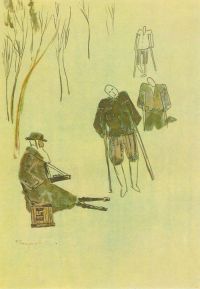
Bogorodsky F.C. War invalids.
From the series "On the streets
of Berlin. Them and us". 1929.
In the post-revolution years not only has Soviet Graphic art reached an exceptional variety of genres and techniques, but developed into an independent art form. If the old Russian masters have considered the drawing, as I.Repin has put it, "the conscience of painting", while at the same time remaining in the background behind painting or sculpture, for the new artists such as G.Vereisky, V.Lebedev, V.Konashevich, N.Kupreyanov, P.Miturich, L.Bruni, N.Tyrsa, V.Favorsky and many others Graphic art has become their one and only love, their sole means for expression of thoughts and emotions, the object of constant care and creative concern.
In the first years after the revolution, the museum life in the country was carried on under the banner of saving the artistic treasures. Works from different sources began to flow into the Tretyakov Gallery in a powerful stream. The main "filtering" organization was the State Museum Fund.
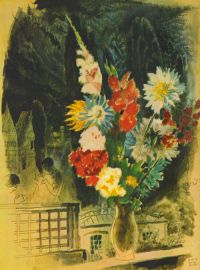
Nivinsky I.I. Flowers. Borzhomi. 1927.
Due to lack of room, the Tretyakov Gallery could not accommodate all this flow of new acquisitions, and its filials began to appear all over Moscow. One may read in the "Sredi kollektzionerov" (Among collectors) journal from 1932 about the so called "Proletarian museums", museum committees and art and history monument preservation committees organized in Moscow at the Soviet of workers and peasants representatives. We know that a few of such museums have becomes the Gallery filials.
The most significant transformation of that time becomes the turning of the collection, known as "Tzvetkov Galley" into a filial of the Tretyakov Gallery in 1919. It deserves a more detailed discussion.
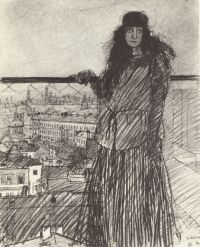
Miturich P.V. Portrait of
Vera Khlibnikova. 1924.
The Tzvetkov Art Gallery was created in 1880s by an important banker I.E.Tzvetkov. He was among the first in Moscow who has turned his attention to collecting drawings of Russian artists. Due to the fact that he had nearly no competitors in this field, he has quickly acquired a the richest collection, encompassing the development of this form of art during about a century and a half. At first, perhaps under the influence of people's tastes and the ideas of M.P. Tretyakov, I.E.Tzvetkov collected the drawings of his contemporaries, the Wanderers. But in the 1900s he has taken to collect the old masters, and these have formed the most valuable part of his drawing collection. In 1909 I.E.Tzvetkov has given his collection to the city of Moscow, while remaining its lifelong trustee. Upon his death in 1917 the collection was finally reformed into a public gallery. In 1919, as stated above, the Tzvetkov gallery has become a filial of the Tretyakov Gallery. Gradually, a few oil paintings it contained were incorporated into the main exposition, and the Graphic Art collection, numbering by that time over 1,500 pages, was turned in 1924 into the Drawing department of the Tretyakov Gallery, and in 1925 it was their territories were merged.
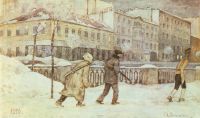
Vakhrameyev A.I. Night watch.
From the series "Types and scenes
from 1917-1920s". 1920.
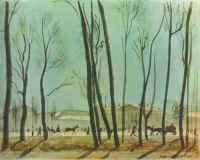
Milashevsky V.A. Summer Garden. 1924.
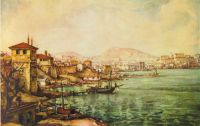
Bogayevsky K.F. Feodosiya. 1927.
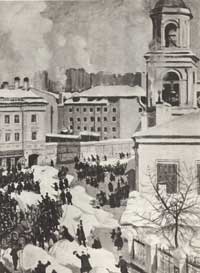
Falk R.R. Girls wearing costumes. 1920s.
It is possible that the merging would not have held such significance for the future expansion of the Graphic Art collection, had the young scientific staff not moved also to the Tretyakov Gallery together with the works. These were enthusiasts of the Graphic Arts, headed by the Moscow University professor Anatoly Vasilievich Bakushinsky. From 1918 until 1925 A.V.Bakushinsky has managed the Tzvetkov gallery, or rather - was its heart and brain. By the force of his great love for art, which has attracted people to him, especially young people, he managed to turn a small museum into a kind of scientific research institute. While teaching a course by the humble name "Art education" at the Moscow University and dealing with extra-curriculum education problems with the A.L.Shanyavsky City University students A.V.Bakushinsky has formed around him a nucleus of young art critics. Created spontaneously, on the young people's initiative, this group was soon officially acknowledged as the Center of methodical training of specialists, guides of art excursions at the NARKOMPROS museum department. Bakushinsky could not envision aesthetic education without a connection to living contemporary art. Perhaps for the first time in history, a mutually beneficial cooperation began to appear between the art critics and the artists, in which the artists assist the critics to unravel the secrets of their craft, and the critics then spread the artists' potential perspectives for artistic creation through the flight of their theoretical thought. The sculptor V.Domogatzky, the architect I.Zholtovsky, the graphic artist V.Falileyev and others served as standing consultants at Tzvetkov gallery. Bakushinsky applied himself enthusiastically to research of such new questions in the Russian Art as the nature of a child's creativity (and from here the child's psychology); the interaction between professional and folk art (and from here his interest in primitive art and assistance in recreation of the Palekh, Mstyora and Fedoskino crafts). He was the first to study the art of the Soviet nations. It is not surprising that those who remember Bakushinsky say that he was not just an art critic, but a researcher of arts. "When one considers the direction of his whole activity," remembers M.V.Avlatov, "one would easily notice that his search comes from a holistic, clear approach to the world; each study is a link in the single chain of thought, an unbroken thread of attempts to uncover the essence of art; to experience with it with his whole being; to discover the rule forming it; to bring other people into this world and help the art itself to find a fruitful path in life".
Bakushinsky's furious activity in the first post-revolution years has brought him to study drawing and watercolor, with which he has come in close contact in his work at the Tzvetkov gallery. From the very first acquaintance with its collection he has immediately understood that "The Tzvetkov drawing collection opens up wide research possibilities both in the art critic field and in the mere technical searching. In the latter field we may achieve most interesting and compete results. The collection provides rich, nearly endless data on the history of all forms of execution and professional-technical processing of the drawing material existing through the history of Russian art; of the inherent evolution of each separate method with conjuncture with this or that material; and finally of the characteristics of the execution process itself. For example, one can monitor this way the history of drawing with a pencil, pen and ink, gouache, pastel and especially watercolor; the history of their inter-relationship, the relationship to oil, sculpture and architecture against the general development of Russian art".
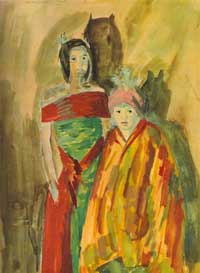
Kustodiev B.M. February 27th 1917. 1917.
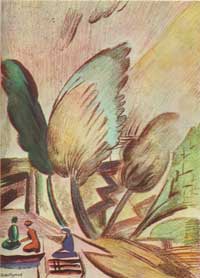
Kuznetzov P.V. Chaikhana. A page from
the album "Mountain Bukhara". 1922.
It should be note that Bakushinsky was most interested during those years in the technical possibilities of Graphic art, its specific solutions in the narrow professional meaning. It is easy to understand: a perfectly new form of art for the Russian researcher demanded a study of its nature; make out its very aesthetic essence, inseparably connected to the execution technique; understand the secret of the emotional effect of all its elements.
Upon heading the new Department of drawing at the Tretyakov Gallery after the Tzvetkov collection was moved there, A.V.Bakushinsky and his young assistants have immersed themselves in the study of Graphic art in all its versatility. The art of the XX-th century, multifaceted and contradictory, stormy in its social interest, has given the scientists an extraordinary amount of material. The very first question arising before them was what is to be considered in contemporary art a worthy acquisition for the treasury of Russian art; how to not make a mistake while selecting works for the gallery by living artists; how to remain objective, while being personally acquainted with many of the masters, knowing their cares, difficulties and challenges as well as their often unfriendly position towards each other. Firm guidelines were needed both in the evaluation of art and in museum ethics. Regarding the latter, one of its points was the demand made by Bakushinsky from his colleagues to give up accumulation of personal collections, which could have damaged the expansion of the museum collection. This demand has been accepted and is still being religiously carried out at the Tretyakov Gallery. As to the collecting principles, they have been logically derived from Bakushinsky's approach of the time to art as a whole. In his brochure "Museum-aesthetic excursions", published in 1919, he wrote of the equal value of all historical art monuments, bringing the aesthetic principle to the foreground in the evaluation of a work of art. This was the deciding approach in the artists' works selection criteria as well, in the beginning of forming the collection of contemporary graphic art. Often the artist's social stand was so far removed from his leading aesthetic approach, that it required great intellectual effort to unravel this contradictory knot. Exhibition analysis came first, and there was a multitude of them opening all over Moscow and Leningrad. But this method carried the danger of chance and mistake, as the creation of this or that artist was represented in a fragmentary manner at the public exhibitions. Therefore the gallery began to practice personal expositions, allowing a better and wider perspective. Thus, even still at the Tzvetkov gallery an exposition was made of the drawings of an artist V.Chekrygin, who has died young, at the end of which the best pages were received by the gallery as a gift.
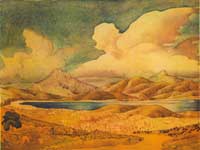
Voloshin M.A. Chimeras. 1927.
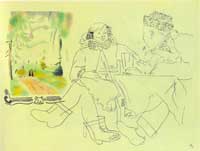
Konashevich V.M. At the table (Beer bar).
From the series "Little stories". 1927.
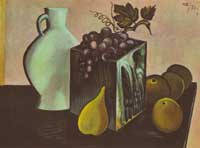
Shevchenko A.V. A jug and fruit. 1931.
The second important issue was the direct creative contact wit the artists. In addition to visiting the studios, where selection of works was performed, the gallery specialists held conversations and questionings, recording in detail the artist's biography, his work methods and techniques, his artistic principles. At the gallery's manuscript department there is a selection of records from these conversations with the leading watercolor masters of that time. Such masters as E.Lancere, P.Konchalovsky, A.Lentulov, K.Petrov-Vodkin, N.Kupreyanov, L.Bruni, A.Fonvisin and others have shared their secrets with the art critics.
As a result of this detailed and scrupulous work the first exhibition of graphic art was organized, titled "The Russian drawing in the decade of October Revolution", which opened in the autumn of 1927 at the Tretyakov Gallery halls. From the following acquisition one may see how the principle of the social significance of art, its alignment with the party was moved inexorably forward and strengthened. Compare the drawings from the 1927 exhibition, brilliant but closed in their chamber feel, such as "A plate with cherries" by D.Shterenberg; "Portrait of the artist's wife" by L.Bruni; "A square in a provincial town" by N.Altman; "A table with flowers and china" by P.Lvov; with the works acquired in the 1930s, especially from the exhibition titled "The RSFSR artists in the last 15 years", such as: "The Mars field" by A.Ostroumova-Lebedeva; "Makhnovshchina" by A.Tyshler; "Dnieprostroy" by A.Kravchenko; whole series of "Railroad" drawings by N.Kupreyanov or "The years and the people" by P.Sokolov-Skalya; the pages by V.Lebedev and V.Konashevich, exposing the sores of the NEP epoch; the series of prints "The woman in the revolution" by E.Sakhnovskaya; and "The life of Lenin" by P.Staronosov. All these works are so unlike each other, not only in the high aesthetic aspect but only the civil significance. And their part with respect to the flow of new acquisitions has grown.
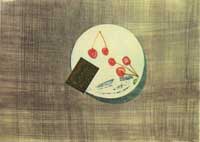
Shterenberg D.P.
A plate with cherries. 1918.
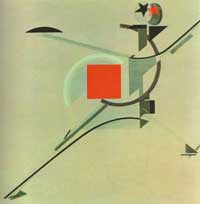
Lissizky L.M. New. A page from album
"Figures from the opera "Victory over
the sun" by A.Kruchenykh. 1920-21
In 1936, in an interview given to the journal "Art" on his review of graphic works at the autumn exhibition, A.V.Bakushinsky is not only amazed by its high professionalism, but almost hods that against it. He says that this exhibition is "first and foremost a mass parade of a significant and really formal quality, often of mastery beyond doubt or question, of sure, sharp techniques, at times too refined. Everything is in order in this respect. The level is high enough". Then he answers a number of questions, introducing a new Bakushinsky criterion, his new requirement: "But then, how about the artist's thought, his emotion? His character and his imaging process? What does his heart love and how? How is it beating?" "In all regularly and calmly, too calmly", he answers himself, and a genuine concern is heard for the contemporary art. Behind the seeming calmness he perceives a fearful tendency of some artists retreating into a world of narrow personal concerns. "It is a base of low effort and little potential", he writes. "It is a strange, incomprehensible fear of breaching the limits of observationism. The measuring of all the depth and width of Soviet reality with the measure of a study, a fast, almost instant sketch. The retreat to something elementary, something very simple. This has been thus in the past, but now is no longer enough".
The Museum was first in collecting prints, however in the collection of illustrations by Soviet artists the "influence sphere" was divided a bit differently. It is widely known, that a print in a book connects most organically with printing. Therefore, in their collection the Museum has discovered a natural need to collect ex-libris designs, decorations and, naturally, illustrations. From prints the collectors' interests moved to original drawing for books, especially when its composition was tightly connected with the text placement on the page.
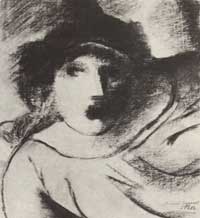
Chekrygin V.N. The uprising.
Composition detail..
Summing up all said above about the activity of the Department of drawing, under A.V.Bakushinsky's leadership, which continued until the death of this remarkable inquisitive researcher and enthusiast in 1939, one should note that during that time the collection of Soviet graphic art was created; the basic principles formulated for its expansion and maintenance; the perspectives laid down for its study; contact made with the contemporary artists. One alarming thing remained: following the traditions of P.M.Tretyakov and I.E.Tzvetkov, during all these years the gallery emphasized the collection of Russian drawing and watercolor, and these made the main part of the collection; the prints were collected not as avidly or carefully. To this day the Tretyakov Gallery collection of Russian and Soviet prints is greatly inferior to that of the Print Cabinet at the A.S.Pushkin State Museum of Fine Arts, though it does represent all the leading masters.
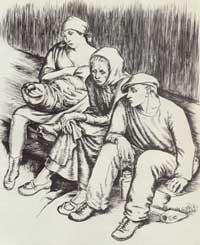
Kassyan V.I. The family of an
unemployed man. Prague. 1925.
In 1930s two lines have formed in the Russian art of illustration. If we try to coarsely define them, then the first acknowledged the supremacy of the book's decorative ensemble over the separate illustration, whereas the second gave preference to a painting-like, if we may say so, unfolding of the literary image. The second principle of illustration, brought forth by the artists D.Shmarinov, S.Gerasimov, E.Kibrik, B.Dekhterev, Kukryncy, at the time followers of D.N.Kardovsky, has found support in A.M.Gorky. It allowed new possibilities of ideological-emotional analysis of a work of literature, the exposure of the literary hero's character in development, demonstration of an epoch in its multifaceted variety. At the Tretyakov Gallery, with its preference of easel art forms, the illustrations of these artists have also found their fans. Today they are well and fully represented at the Gallery. And right by them are works of their predecessors: the artists A.Laptev, D.Dobuzhinsky, O.Vereisky, who worked in the postwar years in the same principles of "easel" tone illustration.
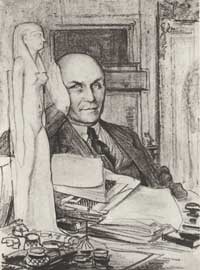
Falileyev V.D. Portrait
of A.V.Bakushinsky. 1923.
The illustration of the first type, performed in the printing technique or dynamic ink drawing, based on decorative principles, were collected mainly by the A.S.Pushkin State Museum of Fine Arts.
In the tough years of the Great War (WWII), the Gallery Drawing Department was evacuated on its collection deep into the back of the country, but its expansion has never ceased, and was especially lively in the first postwar years. Sketches from nature brought by the artists from the frontiers were given great importance. Living pulse was felt in them, even if lacking artistry. The first among these documentary drawings were the graphic journals if the artists L.Soifertis and S.Uranova; then later I.Yevstigneyev, N.Simonovich-Efimova. The drawing collection in the postwar years was constantly added to, though the graphic department has ceased to exist as a separate entity.
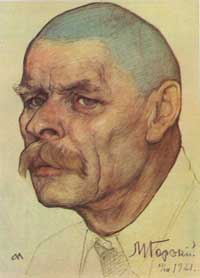
Andreyev N.A. Portrait of A.M.Gorky. 1925.
Naturally, most of the attention was paid to painting and one may easily imagine how gradually, step by step, the specific demands of the graphic art collection were being lost. It was constantly expanded by the care of a few enthusiasts, but the source of these were mainly ongoing exhibitions, and more rarely the artists studios. There was no collective effort of graphic art specialists, which alone can move along the objective evaluation of works, acquired for the gallery collection. The study of the collection has all but gone out. Sculpture has arrived at the same situation. All this could not fail to alarm the gallery leadership, and at the beginning of 1960s autonomous Sculpture and Drawing Departments were reinstated and united with their funds. The problems, standing before the newly re-formed Department of Graphic Art were very great. The Department was called upon to begin, immediately, activity in the study, exhibition, popularization fields as well as bringing order to the collection expansion. The Department staff were to create anew the living connections with contemporary graphic artists, be carefully attentive to the day's demands and quickly respond to them.
In pursuit of these goals, the Department has organized as early as 1964 its first exhibition of Soviet easel drawing in the period of 1917 to 1945, which has resonated greatly. Not only has it allowed to see, after a long period of separation, the drawing masters' brilliant works and has thus become a celebration for the spectators; not only facilitated closer relationships between the staff, selecting works for it from the richest funds; but has supported in the hearts of the artists that interest to original drawing, which was ripening in the depths of the common affiliation with prints.
The idea of organizing a second large exhibition, realized in 1966-67, titled "The Russian watercolor of late XVIII - early XX centuries", originated directly from the artists' wishes, gathered to discuss their 1st All-Union exhibition of watercolor in 1965. They needed a school, and they have gotten it. Who else but the Gallery could show them this finest and most difficut of arts in all its glory.
The article is translated from the Womenstown website, www.womenstown.ru/articles/198 (Russian), and signed simply by Vera (not myself, obviously). Hope you have enjoyed it.
If you would like to comment, discuss or otherwise express anything about this article - you are welcome to do so here, at the forum topic.
|

